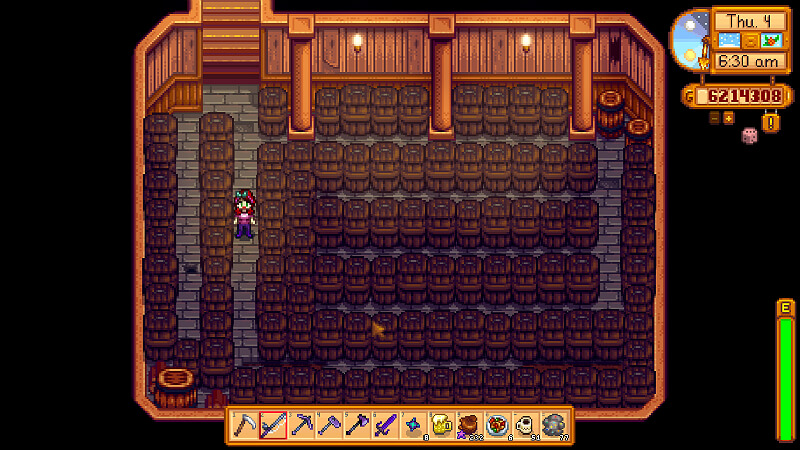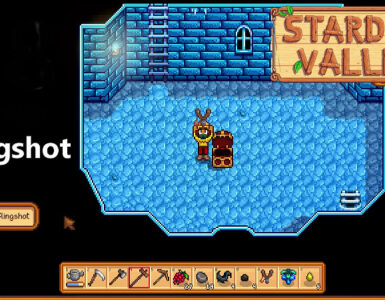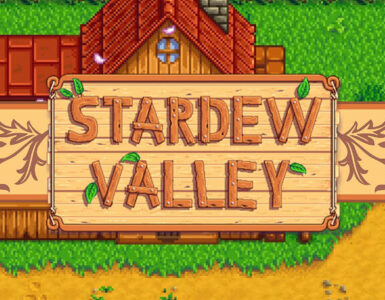I’ve been reading some of the posts around casks and I’m hoping I can help people understand why they are useful and profitable within the SDV farm economics. Here’s a couple of points I hope will help clarify their importance in the game:
Casks are items for mid to later gameplay
If you can lay out 100k for the cellar option (on top of combined 60k, 450 wood, and 150 Hardwood for the previous upgrades), chances are very good that you are not working hand-to-collection-box to make money to get you to the next crop purchase. You certainly have upgraded tools (given the volume of Hardwood needed for House Upgrade #2) and have built other income sources that you are tending (animals, crops, taps, honey, etc). In addition, the machines that make the products that proceed casking are obtained at Farming 6 (Cheese Press) and Farming 8 (Keg). Casks shouldn’t even be on the horizon without these items in play so it is not an early game item to be concerned about.
Casks are an investment
The majority of the complaints I have read are about the aging process in which it takes 2 months for wine to go from regular to iridium and therefore it is not worthwhile. This is a rather limiting argument since it has chosen the lengthiest of the aging processes and for only one of the items, you can use the cask for. I’m going to try to illustrate why casks are good economically as an investment.

Let’s say you have an apple. You could sell the apple now for 10 or you can sell in a week for 20. If you need the money now, selling the apple for 10 makes sense because of demand. But if you don’t need the money now and you can wait a week, selling the apple for 20 is the better course of action to take. It’s more of a wait but you get a better price for the same product.
Casks function the same way; you defer selling now to get a better price point in the future. Here’s some back of the napkin calculations that may help drive home the point, going from base price to iridium and their time and express it as profit per day.
- Pale Ale: 300g vs 600g (28 days, +10.7g/day, on par with Yams)
- Beer & Mead: 200g vs 400g (28 days, +7.1g/day, on par with Potatoes)
- Cheese: 200g vs 400g (14 days, +14.2g/day, on par with Melons)
- Goat Cheese: 375g vs 750g (14 days, +26.7g/day, just short of 30g/day of Starfruit)
- Starfruit Wine: 2250g vs 4500g (48 days, +46.9g/day, second only to Rare Seed Fruits at 80g/day)
(If my math is askew, please let me know.)
To me, that is a pretty compelling case for casks. It takes time to establish (making casks, getting input materials), but it’s a guaranteed solid investment with 100% returns.
Casks work both short and long term and work well with different quality items
Given the profit per day numbers above, you can choose whether you want to be hands off (any of the drinks, especially wines) and check on it every week or so or be more involved with every few days of cheese aging. It fits different playstyles and different approaches to the game.

It should not be forgotten that not everything going into the casks needs to be regular level. You can put in silver and gold star quality materials (cheeses exclusively at the moment) and get the next upgrade within a few days. It’s a fast way to turn a profit if you don’t want to wait for all the quality steps to happen.
I hope this helps. I’ve enjoyed the cask and their mechanics and it really adds something new and different to the game. If you are a player who wants to make the most money, then casks are a way to boost your profit margin without additional crops, animals, or hives.
Thank you. I look forward to your feedback.
Edit1: Formatting
Edit2: If you want a reminder about the timing, stick a keg by the entrance to the cellar just inside your kitchen. Put a veggie in the keg for juice if you are making cheese (since it takes 4 days to process) or a fruit for wine (7 days) to match up with whatever cask product you making.
Edit3: Wine math was incorrect. DOH!
Edit4: Changing Starfruit prices in 1.11 change the final product.
Edit5: Added lines about skills levels.
Original Link – Continuation of discussion






Add comment